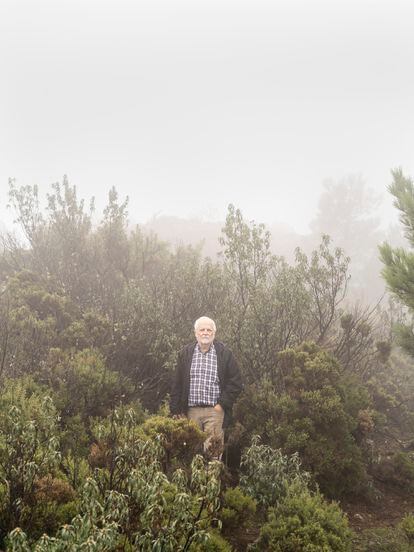In the Conservatory and Botanical Garden of the Swiss city of Geneva, inside large metal cabinets in the basement -1 of the herbarium of phanerogamic plants, the original samples are kept with which one of the largest was recorded for science in the 19th century singularities of Iberian trees: the Spanish fir.
They are fragments of branches and pine cones collected in 1837 by the Swiss botanist Edmond Boissier (1810-1885), together with some annotations in his own handwriting that place the find in the Sierra de las Nieves, in Malaga.
Now, 184 years later, only the final procedure remains in the Spanish Parliament to convert this unique space into a national park and shield, among other wonders, these rare conifers.
To understand the particularity of firs, you have to imagine the botanist Boissier seeing for the first time some fir trees similar to those of the cold mountains of the Alps (the typical triangular shaped Christmas trees), but perfectly adapted to the lands punished by the sun of Andalusia.
The scientist, explorer and collector who is credited with the description of almost 6,000 new species found that these Mediterranean conifers were unique and gave them the scientific name of
Abies pinsapo.
From Switzerland, a voice on the other end of the phone enthusiastically receives the news of the prompt declaration of the Sierra de las Nieves National Park, which will be the 16th in Spain and will protect 23,000 hectares with a fabulous diversity of forests.
"The white fir and the Spanish fir once had a unique population, but this separated and specialized in a completely different habitat and climate, these trees from Spain are a great curiosity", comments Michel Grenon, president of the Physical Society and Natural History of Geneva, to which Boissier also belonged.
Bare arms of mountain gall leaves amid the fog, in the future Sierra de las Nieves National Park, which has a great botanical amalgam.Eduardo Nave / EPS
In the 19th century, an expedition through the Andalusian mountains constituted an adventure with many dangers.
Loaded with his role as a herbarium to press and dry the specimens he was collecting, the Swiss explorer recounted in his emblematic work
Botanical Journey through the South of Spain
the strangeness that caused the locals to travel those harsh mountains to collect plants.
“Nobody believed my very simple explanations about the objective of my investigations, it intrigued these good people especially my barometer, they shook their heads with a significant air.
Take skewers, measure mountains and for pleasure, it cannot be…, they said ”, relates the scientist about his explorations through these lonely lands.
If Boissier could return today to the Sierra de las Nieves, next to the Malaga coast and just 25 kilometers from a tourism factory like Marbella, now he would have to overcome a maze of buildings, highways, roundabouts, urbanizations, ornamental palm trees, billboards ... But, after the initial shock, he would suddenly find himself surrounded by forests, in the middle of a sublime landscape.
Emeritus Professor Baltasar Cabezudo Eduardo Nave / EPS
Although there are different routes to enter the future national park, accessing the track that connects Marbella with Ronda is today similar to crossing a magical door.
Before crossing it, even after leaving the asphalt road behind, you can still see machines that build more tourist complexes, already on the very slopes of the mountain, when all the cement unexpectedly disappears.
"I don't know how this has been preserved here," says Baltasar Cabezudo, emeritus professor at the University of Malaga and former president of the Governing Board of the Sierra de las Nieves Natural Park, the body that between 2011 and 2014 launched the procedures to convert this space into a national park, in a process promoted from below, with the support of all sectors of the area.
"In these mountains are the most extensive and best preserved fir trees in the world", underlines the botanist, who explains that, although at present it is known of the existence of other Mediterranean fir trees in the north of Morocco or in Greece, these are considered varieties or different species.
All Spanish firs are concentrated in a few parts of Andalusia, which in turn also represents their greatest vulnerability, especially to fire, which is why this community has the species listed as endangered.
Like Boissier and the classic botanists, Cabezudo and the researcher Federico Casimiro-Soriguer have spent two years touring this space to inventory all its flora.
They have dedicated themselves to getting off the beaten track and getting lost in these mountains collecting samples of all varieties of plants, searching the most hidden corners, the most inaccessible through which they had not passed before.
Still today, while walking through the Sierra de las Nieves, from time to time they take out a small plastic bag to introduce a specimen, as if it were evidence that the scientific police collected from the plants.
After analyzing thousands of samples collected, dried and preserved in the basements of the Malaga Faculty of Sciences, and reviewing digitized sheets of many other herbaria, they have counted 1,620 different plant species.
In this botanical paradise there is much more than Spanish firs.
Mountain gall oaks, with their trunks deformed by the years, the snow and their traditional historical use.Eduardo Nave / EPS
Part of this enormous plant diversity is explained by the geographical situation and the climate of this part of Andalusia.
However, in the case of the Sierra de las Nieves there are also other peculiarities.
One of the most determining factors is the special unevenness of this mid-mountain park, which in a short space goes from 200 meters not far from the sea to 1,919 meters from Torrecilla peak, a difference of more than 1,700 meters.
“In just 1.5 kilometers in a straight line we went from seeing the palm heart [a small native palm tree] to high mountain vegetation, the contrasts are spectacular,” says Casimiro-Soriguer.
Another reason for creating this national park, apart from the firs, are the geological formations of peridotites (serpentines), a very rare magmatic rock in which the vegetation that grows on top also changes.
The result is an incredible botanical amalgam, in which fir forests, cork oaks, gall oaks, holm oaks, junipers, pines, junipers ...
"There are fewer and fewer botanists who go to the field to collect and identify samples," says Cabezudo, who while walking through the future national park every so often makes an exclamation or stops when he sees something new among the plants that he knows so much.
It can be a simple moss, some white flower of the jarales or the yellow bell of a daffodil.
Of all the species that he has inventoried in the Sierra de las Nieves, the retired professor highlights some varieties from the higher parts, such as broom and heaths, junipers and creeping junipers ... And, especially, the mountain gall oaks,
Quercus alpestris Boiss.,
majestic trees with haggard trunks, also described in his day by Boissier.
If there is no doubt about the importance of the geneva in the botany of Andalusia, Cabezudo claims the role of other figures.
This is the case of two pharmacists from Malaga, Félix Haenseler (1766-1841) and Pablo Prolongo (1806-1885), who accompanied him and helped him in his search for Spanish firs in the Sierra de las Nieves.
But also by the botanist Simón de Rojas Clemente (1777-1827), who described the Spanish fir two decades before the Swiss, although not in the correct way for science.
In fact, today it is common to find references of this species such as
Abies pinsapo Clemente ex Boiss.,
To include the two paternities.
The names of these plants are full of stories from the people who have carried out the colossal task of cataloging them to make them known and to be able to protect them.
Before they reached the scientific collections, the Spanish firs were what the inhabitants of these lands called the trees from which they cut branches to take to the processions (because they have the shapes of crosses).
A decrepit fir in the middle of a pine forest.
On the left, a view of the future national park, which ranges from 200 meters high to 1,919 meters from the Torrecilla peak.
Below, emeritus professor Baltasar Cabezudo.Eduardo Nave / EPS
In the Sierra de las Nieves there are many rare varieties, such as the
Centaurea clementei,
a beautiful and strange specimen of yellow flowers that Boissier dedicated to Clemente, but even more relevant are its plant communities.
"A species can be planted in a botanical garden, but what is interesting are these jarales, pastures, cork oaks, pine forests, willows ...", emphasizes the professor from Malaga,
Cabezudoi
in the terminology of plants, who assures that the creation of the park constitutes a milestone in his life as a botanist.
Despite giving this space maximum protection, it does not mean that it will always be the same.
Unlike what happens with a herbarium, a park is not something that can be pressed and dried to preserve it unchanged.
With global warming, Spanish firs have already begun to spread upwards in the mountains and the landscape will inevitably change.















